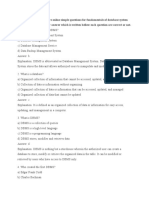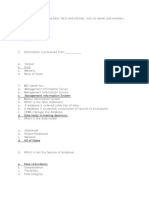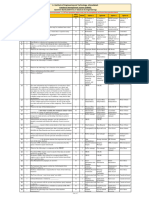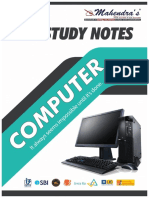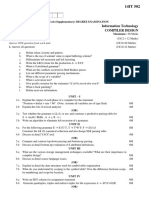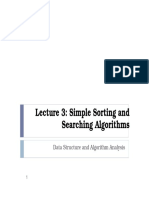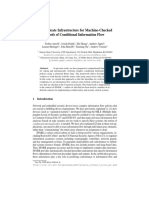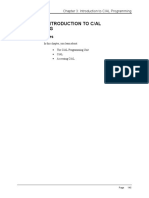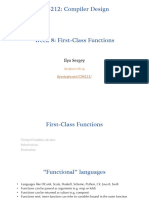True and False :
1-The relational database model was created by E.F. Codd
A-True
B-False
Answer: Option A
2- A database is called "self-describing" because it contains a description of itself.
A-True
B-False
Answer: Option A
3- In a database, data is stored in spreadsheets which have rows and columns.
A-True
B-False
Answer: Option B
4- A database has data and relationships.
A-True
B-False
Answer: Option A
5- One of the reasons why OODBMSs have not been widely used for business
information systems is that OOP is obsolete.
A-True
B-False
Answer: Option B
6- In an enterprise-class database system, business users interact directly with
database applications, which directly access the database data.
A-True
B-False
7- Answer: Option B
8- Applications are programs that interact directly with the database.
A-True
B-False
Answer: Option B
9- The purpose of a database is to help people stop using spreadsheets.
A-True
B-False
Answer: Option B
10- Microsoft Access is an enterprise-class database product.
A-True
B-False
Answer: Option B
11- Structured Query Language (SQL) is an internationally recognized standard language
that is understood by all commercial database management system products.
A-True
B-False
Answer: Option A
12- The XML family of standards is very important in database processing today.
A-True
B-False
Answer: Option A
13- A database has a built-in capability to create, process and administer itself.
A-True
B-False
Answer: Option B
14- Enterprise Resource Planning (ERP) is an example of a single user database.
A-True
B-False
Answer: Option B
15- Prior to 1970, all data was stored in separate files, which were mostly stored on
reels of magnetic tape.
A-True
B-False
Answer: Option A
16- A database design may be based on existing data.
A-True
B-False
Answer: Option A
12. Data is raw facts
True
False
13. Information is processed data
True
False
14. DBMS reduces application development and maintenance time
True
False
15. DBMS stores data efficiently with little wasted space
True
False
16. The primary key does not necessarily have to be unique for a given table.
True
False
17. It is possible that two or more attributes can form a single key.
True
False
18. Records on an electronic database go up and down.
True
False
Choose the right answer:
1.What is the full form of DBMS?
a) Data of Binary Management System
b) Database Management System
c) Database Management Service
d) Data Backup Management System
2. What is a database?
a) Organized collection of information that cannot be accessed, updated, and managed
b) Collection of data or information without organizing
c) Organized collection of data or information that can be accessed, updated, and
managed
d) Organized collection of data that cannot be updated
3. What is DBMS?
a) DBMS is a collection of queries
b) DBMS is a high-level language
c) DBMS is a programming language
d) DBMS stores, modifies and retrieves data
4. Who created the first DBMS?
a) Edgar Frank Codd
b) Charles Bachman
c) Charles Babbage
d) Sharon B. Codd
5. Which type of data can be stored in the database?
a) Image oriented data
b) Text, files containing data
c) Data in the form of audio or video
d) All of the above
6. In which of the following formats data is stored in the database management system?
a) Image
b) Text
c) Table
d) Graph
7. Which of the following is not a type of database?
a) Hierarchical
b) Network
c) Distributed
d) Decentralized
8. Which of the following is not an example of DBMS?
a) MySQL
b) Microsoft Acess
c) IBM DB2
d) Google
9. Which of the following is a feature of DBMS?
a) Minimum Duplication and Redundancy of Data
b) High Level of Security
c) Single-user Access only
d) Support ACID Property
10. Which of the following is a feature of the database?
a) No-backup for the data stored
b) User interface provided
c) Lack of Authentication
d) Store data in multiple locations
11. Which of the following is not a function of the database?
a) Managing stored data
b) Manipulating data
c) Security for stored data
d) Analysing code
12. Which of the following is a function of the DBMS?
a) Storing data
b) Providing multi-users access control
c) Data Integrity
d) All of the above
13. Which of the following is a component of the DBMS?
a) Data
b) Data Languages
c) Data Manager
d) All of the above
14. Which of the following is known as a set of entities of the same type that share same
properties, or attributes?
a) Relation set
b) Tuples
c) Entity set
d) Entity Relation model
15. What is information about data called?
a) Hyper data
b) Tera data
c) Meta data
d) Relations
16. What does an RDBMS consist of?
a) Collection of Records
b) Collection of Keys
c) Collection of Tables
d) Collection of Fields
17. The values appearing in given attributes of any tuple in the referencing relation must
likewise occur in specified attributes of at least one tuple in the referenced relation,
according to _____________________ integrity constraint. a) Referential
b) Primary
c) Referencing
d) Specific
18. _____________ is a hardware component that is most important for the operation
of a database management system. a) Microphone
b) High speed, large capacity disk to store data
c) High-resolution video display
d) Printer
19. The DBMS acts as an interface between ________________ and ________________
of an enterprise-class system. a) Data and the DBMS
b) Application and SQL
c) Database application and the database
d) The user and the software
20. The ability to query data, as well as insert, delete, and alter tuples, is offered by
____________
a) TCL (Transaction Control Language)
b) DCL (Data Control Language)
c) DDL (Data Definition Langauge)
d) DML (Data Manipulation Langauge)
21. ______________ is a set of one or more attributes taken collectively to uniquely
identify a record. a) Primary Key
b) Foreign key
c) Super key
d) Candidate key
22. Which command is used to remove a relation from an SQL?
a) Drop table
b) Delete
c) Purge
d) Remove
23. Which of the following set should be associated with weak entity set for weak entity
to be meaningful? a) Neighbour set
b) Strong entity set
c) Owner set
d) Identifying set
24. Which of the following command is correct to delete the values in the relation
teaches?
a) Delete from teaches;
b) Delete from teaches where Id =’Null’;
c) Remove table teaches;
d) Drop table teaches;
25. Procedural language among the following is __________
a) Domain relational calculus
b) Tuple relational calculus
c) Relational algebra
d) Query language
26. What is the full form of DBMS?
a) Data of Binary Management System
b) Database Management System
c) Database Management Service
d) Data Backup Management System
27. What is a database?
a) Organized collection of information that cannot be accessed, updated, and managed
b) Collection of data or information without organizing
c) Organized collection of data or information that can be accessed, updated, and
managed
d) Organized collection of data that cann
28. What is DBMS?
a) DBMS is a collection of queries
b) DBMS is a high-level language
c) DBMS is a programming language
d) DBMS stores, modifies and retrieves data
29. Which type of data can be stored in the database?
a) Image oriented data
b) Text, files containing data
c) Data in the form of audio or video
d) All of the above
30. Which of the following is not an example of DBMS?
a) MySQL
b) Microsoft Acess
c) IBM DB2
d) Google
31. What is the full form of DBMS?
Data of Binary Management System b)
Database Management System
c) Database Management Service
d) Data Backup Management System
32. What is a database?
Organized collection of information that cannot be accessed, updated and managed. b)
Collection of data or information without organizing.
c) Organized collection of data or information that can be accessed, updated and
managed.
d) Organized collection of data that cannot be updated.
33. What is DBMS?
a) DBMS is a collection of queries
b) DBMS is a high-level language
c) DBMS is a programming language
d) DBMS stores, modifies, and retrieves data
34. The DBMS acts as an interface between ________________ and ________________
of an enterprise-class system.
Data and the DBMS
b) Application and SQL
c) Database application and the database
d) The user and the software) Data and the DBMS
35. Which type of data can be stored in the database?
a) Image-oriented data
b) Text, files containing data
c) Data in the form of audio or video
d) All of the above
36. The ability to query data, as well as insert, delete, and alter tuples, is offered by
_____
TCL (Transaction Control Language) b)
DCL (Data Control Language)
c) DDL (Data Definition Language)
d) DML (Data Manipulation Language)
37. Primary kay can be____
Null
b) Not Null
c) Both Null and Not Null
d) Depends on the situation
38. Which of the following refers to the level of data abstraction that describes exactly
how the data is stored?
File level
b) physical level
c) conceptual level
d) Logical level
39. Which one of the following refers to the copies of the same data (or
information) occupying the memory space at multiple places?
Data Repository
Data Inconsistency
Data Mining
Data Redundancy
40. Which of the following is known as a set of entities of the same type that share
the same properties, or attributes? a) Relation set
b) Tuples
c) Entity set
d) Entity Relation model
41. What is information about data called?
a) Hyperdata
b) Tera data
c) Metadata
d) Relations
42. Which of the following products was an early implementation of the relational
model developed by E.F. Codd of IBM?
A. IDMS
B. DB2
C. dBase-II
D. R:base
43. The following are components of a database except ________ .
A. user data
B. metadata
C. reports
D. indexes
44. An application where only one user accesses the database at a given time is an
example of a(n) ________ .
A. single-user database application
B. multiuser database application
C. e-commerce database application
D. data mining database application
45. An on-line commercial site such as Amazon.com is an example of a(n) ________ .
A. single-user database application
B. multiuser database application
C. e-commerce database application
D. data mining database application
46. Which of the following products was the first to implement true relational algebra in
a PC DBMS?
A. IDMS
B. Oracle
C. dBase-II
D. R:base
47. SQL stands for ________ . A. Structured Query Language
B. Sequential Query Language
C. Structured Question Language
D. Sequential Question Language
48. Because it contains a description of its own structure, a database is considered to be
________ .
A. described
B. metadata compatible
C. self-describing
D. an application program
49. The following are functions of a DBMS except ________ .
A. creating and processing forms
B. creating databases
C. processing data
D. administrating databases
50. Helping people keep track of things is the purpose of a(n) ________ .
A. Database
B. Table
C. instance
D. relationship
51. Which of the following products implemented the CODASYL DBTG model?
A. IDMS
B. DB2
C. dBase-II
D. R:base
52. An Enterprise Resource Planning application is an example of a(n) ________ .
A. single-user database application
B. multiuser database application
C. e-commerce database application
D. data mining database application
53. A DBMS that combines a DBMS and an application generator is ________ .
A. Microsoft's SQL Server
B. Microsoft's Access
C. IBM's DB2
D. Oracle Corporation's Oracle
54. You have run an SQL statement that asked the DBMS to display data in a table
named USER_TABLES. The results include columns of data labeled "TableName,"
"NumberOfColumns" and "PrimaryKey." You are looking at ________ . A. user
data.
B. metadata
C. A report
D. indexes
55. Which of the following is not considered to be a basic element of an enterprise-class
database system?
A. Users
B. Database applications
C. DBMS
D. COBOL programs
56. The DBMS that is most difficult to use is ________ .
A. Microsoft's SQL Server
B. Microsoft's Access
C. IBM's DB2
D. Oracle Corporation's Oracle
57. What is the full form of DBMS?
Data of Binary Management System
Database Management System
Database Management Service
Data Backup Management System
58. What is a database?
Organized collection of information that cannot be accessed, updated, and managed
Collection of data or information without organizing
Organized collection of data or information that can be accessed, updated, and
managed
Organized collection of data that cannot be updated
59. What is DBMS?
DBMS is a collection of queries
DBMS is a high-level language
DBMS is a programming language
60. Who created the first DBMS?
Edgar Frank Codd
Charles Bachman
Charles Babbage
Sharon B. Codd
61. Which type of data can be stored in the database?
Image oriented data
Text, files containing data
Data in the form of audio or video
All of the above
62. In which of the following formats data is stored in the database management
system? Image
Text
Table
Graph
63. Which of the following is not a type of database?
Hierarchical
Network
Distributed
Decentralized
64. Which of the following is not an example of DBMS?
MySQL
Microsoft Acess
IBM DB2
Google
65. Which of the following is a feature of DBMS?
Minimum Duplication and Redundancy of Data
High Level of Security
Single-user Access only
Support ACID Property
66. Which of the following is a feature of the database?
No-backup for the data stored
User interface provided
Lack of Authentication
Store data in multiple locations
67. Which of the following is not a function of the database?
Managing stored data
Manipulating data
Security for stored data
Analysing code
68. Which of the following is a function of the DBMS?
Storing data
Providing multi-users access control
Data Integrity
All of the above
69. Which of the following is a component of the DBMS?
Data
Data Languages
Data Manager
All of the above
70. Which of the following is known as a set of entities of the same type that share
same properties, or attributes?
Relation set
Tuples
Entity set
Entity Relation model
71. What is information about data called?
Hyper data
Tera data
Meta data
Relations
72. What does an RDBMS consist of?
Collection of Records
Collection of Keys
Collection of Tables
Collection of Fields
73. The values appearing in given attributes of any tuple in the referencing relation
must likewise occur in specified attributes of at least one tuple in the referenced
relation, according to _____________________ integrity constraint.
Referential
Primary
Referencing
Specific
74. _____________ is a hardware component that is most important for the operation
of a database management system.
Microphone
High speed, large capacity disk to store data
High-resolution video display
Printer
75. The DBMS acts as an interface between ________________ and ________________
of an enterprise-class system.
Data and the DBMS
Application and SQL
Database application and the database
The user and the software
76. ER modeling is primarily used for Database Programming
Organizing Databases
Designing Databases
None of the above
77. The set of permitted values for an attribute is called as
Entity Set
Domain
Value Set
Both Domain and Value Set
78. An attribute which can have many values for a single entity is called as
Composite Attribute
Descriptive Attribute
Derived Attribute
Multivalued Attribute
79. The first step in database design is
Physical Database Design
Logical Database Design
Conceptual Database Design
Requirements Gathering and Analysis
80. A relationship is an association between
Two or more Entities
One or more Entities
Entities and Attributes
One or more Attributes
81. Which of the following is not the disadvantage of File Processing System?
Data isolation
Atomicity Problems
Data Redundancy
None of the above
82. The status of a relational table at a particular moment is called
Logical Schema
Metadata
Instance
Subschema
83. Data-Manipulation Language (DML) is a language that enables users to
Design the Database
Insert Data into the Database
Control the Transactions in Database
Define User Privileges

